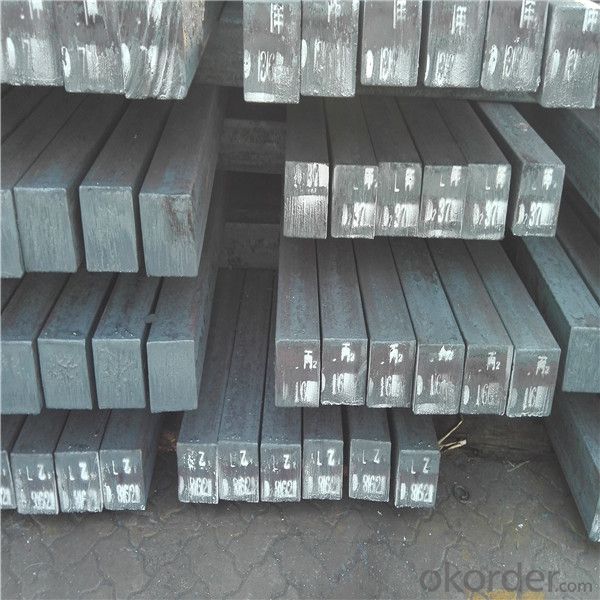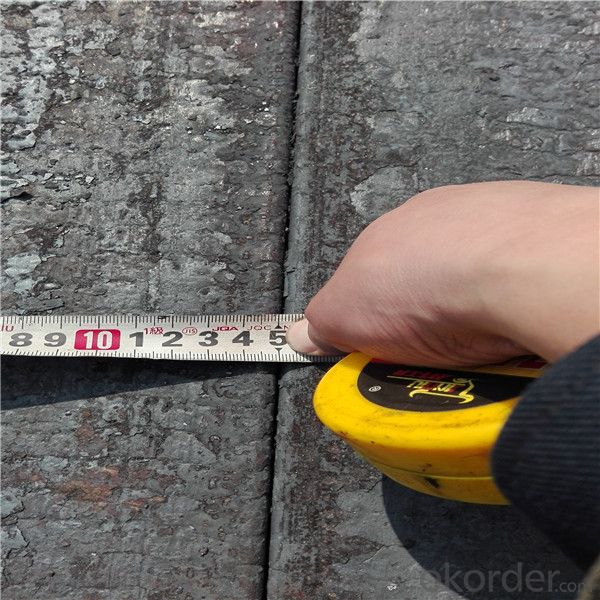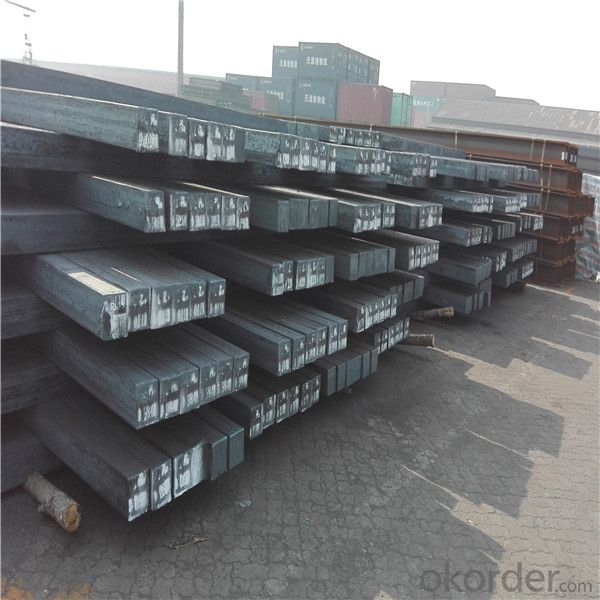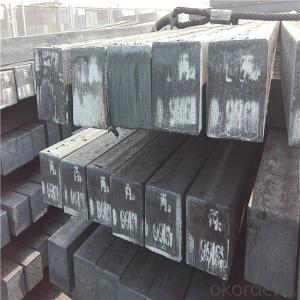Mild steel billet in China Q215/Q195/Q235/Q275
- Loading Port:
- Guangzhou
- Payment Terms:
- TT OR LC
- Min Order Qty:
- 1000 m.t.
- Supply Capability:
- 24531 m.t./month
OKorder Service Pledge
OKorder Financial Service
You Might Also Like
Item specifice
Steel billet
Steel billets have distinct characteristics as compared with already furnished steel bars and products. Billets
have a specific grain structure, which enables the metal to be processed more intricately. Steel billets are also
known for their malleability and ductility, especially when exposed to varying temperatures during shaping and molding.
Billet: equal cross section width and height, or a huge difference, mainly used for rolling steel, wire rod. ,
Tolerance: Strictly according to the G/B and JIS standard
Delivery time: within 45 days after receiving the L/C or advanced T/T payment.
Payment terms: 100%Irrevercable L/C at sight or T/T
Gade:
Standard | C(%) | Mn(%) | S(%) | P(%) | Si(%) |
Q195 | ≤0.12 | ≤0.50 | ≤0.040 | ≤0.035 | ≤0.30 |
Q235 | ≤0.20 | ≤1.40 | ≤0.045 | ≤0.045 | ≤0.35 |
Q275 | ≤0.22 | ≤1.50 | ≤0.045 | ≤0.045 | ≤0.35 |
20MnSi | 0.17-0.25 | 1.2-1.6 | ≤ 0.050 | ≤ 0.050 | 0.40-0.80 |
3SP | 0.14-0.22 | 0.40-0.85 | ≤ 0.050 | ≤ 0.040 | 0.05-0.15 |
5SP | 0.28-0.37 | 0.50-1.00 | ≤ 0.050 | ≤ 0.040 | 0.15-0.30 |



Our service :
We have a plant and professional team to provide our best service, from the start of production until the
loading into the vessel, we have a complete quality follow up procedure, to assure our products arrives to the customer with satisfaction. Welcome new and old customers
to contact us for future business relationships! We will give you a surpise price.
Packing :
Within 30 days
1.Standard export package
2.In bundles with steel strips
3.As the requirements of the customers
FAQ:
Q: What is payment terms?
A: FOB 30% T/T IN ADVANCE AS DEPOSIT AND 70% T/T BEFORE SHIPMENT
CIF and CFR 30% T/T IN ADVANCE AS DEPOSIT AND 70% T/T AS THE COPY OF B/L OR L/C AT SIGHT
Q:How to guarantee the quality of the products?
A:We have established the international advanced quality management system,every link from raw material
to final product we have strict quality test;We resolutely put an end to unqualified products flowing into the market.
At the same time, we will provide necessary follow-up service assurance.
Q:How long can we receive the product after purchase?
A :In the purchase of product within three working days, We will arrange the factory delivery as soon as possible.
The pecific time of receiving is related to the state and position of customers.
- Q:How are steel billets inspected for quality?
- Steel billets are typically inspected for quality using various non-destructive testing methods such as visual inspection, ultrasonic testing, magnetic particle inspection, and dye penetrant testing. These tests help identify any surface defects, cracks, or internal flaws in the billets, ensuring that they meet the required quality standards before further processing.
- Q:How are steel billets used in the manufacturing of automotive parts?
- Steel billets are an essential raw material used in the manufacturing of automotive parts. These billets, which are typically short, solid pieces of steel, serve as the starting point for various automotive components. Firstly, steel billets are heated and then passed through a series of rolling mills to convert them into different shapes and sizes. This process, known as hot rolling, allows the steel billets to be transformed into bars, rods, or sheets that can be further machined or formed into automotive parts. The automotive industry relies heavily on steel billets to produce a wide range of components, such as engine blocks, crankshafts, suspension parts, and chassis frames. These parts require high strength and durability to withstand the demanding conditions of vehicles. Engine blocks, for example, are typically made from cast iron or aluminum alloys produced from steel billets. The billets are melted and poured into molds to create the desired shape, which forms the foundation of the engine. Similarly, crankshafts, which transfer power from the engine to the wheels, are often forged from steel billets to ensure strength and precision. Suspension parts, such as control arms and torsion bars, also rely on steel billets for their manufacturing. These parts need to withstand the forces and impact of the road, and steel provides the necessary strength and resilience. Billets are machined and shaped to create the required geometry and then assembled with other components to form the suspension system. Additionally, steel billets are used in the production of chassis frames, which provide the structural integrity and support for the entire vehicle. These frames are typically made from steel tubes or sections formed from billets. The billets are shaped, welded, and joined together to create a strong and rigid framework that gives stability and ensures safety. In conclusion, steel billets play a crucial role in the manufacturing of automotive parts. With their versatility and strength, they are transformed into various components that form the backbone of vehicles, ensuring durability, performance, and safety on the road.
- Q:How are steel billets used in the manufacturing of railway wagons?
- Steel billets are used in the manufacturing of railway wagons as they serve as the raw material for various components such as frames, side panels, and undercarriages. These billets are first heated and then shaped into the desired form through processes like rolling or forging. The resulting components are strong, durable, and able to withstand the rigorous demands of railway transportation, ensuring the safety and reliability of the wagons.
- Q:How are steel billets different from steel bars?
- Steel billets and steel bars are commonly used steel products in various industries, but they have some distinct differences. 1. Shape and Size: Steel billets are typically square or rectangular and have larger cross-sectional areas compared to steel bars. They are usually produced in sizes ranging from 100x100mm to 150x150mm or larger. In contrast, steel bars come in various shapes, such as round, square, flat, or hexagonal, and are available in smaller sizes based on their intended application. 2. Manufacturing Process: Steel billets are made through a primary steelmaking process known as continuous casting or ingot casting. This process involves solidifying molten steel into a semi-finished product, which is then further processed into steel bars or other forms. Conversely, steel bars are produced through a secondary steelmaking process called hot rolling or cold drawing. This process entails passing the steel billet through a series of rolling mills or drawing machines to achieve the desired shape and size. 3. Usage: Steel billets are primarily used as raw materials for manufacturing various steel products, including bars, rods, wire, pipes, and structural steel sections. They serve as a starting point for further processing and shaping. On the other hand, steel bars are the finished products used in construction, manufacturing, and other industries. They are commonly utilized in the production of reinforced concrete structures, automotive components, machinery parts, and tools. 4. Composition and Properties: Steel billets and bars are both made from carbon steel or alloy steel, but the specific composition and properties may vary depending on the desired end use. Steel billets are often made from low-carbon or mild steel, which provides good formability and weldability. In contrast, steel bars can be made from a wide range of steel grades, including low carbon, medium carbon, and high carbon steels, as well as alloy steels. The choice of steel grade depends on the desired mechanical properties, such as strength, hardness, and ductility. In summary, steel billets are semi-finished products used as raw materials for manufacturing steel bars and other steel products. They differ from steel bars in terms of shape, size, manufacturing process, usage, and composition.
- Q:How are steel billets used in the production of construction components?
- Steel billets are an essential raw material in the production of construction components. They are primarily used in the manufacturing of various structural elements such as beams, columns, and bars that form the framework of buildings and infrastructure projects. The process begins with steel billets, which are semi-finished products made from molten steel that has been cast into rectangular or square shapes. These billets are then further processed and transformed into specific construction components through various manufacturing techniques. One common application of steel billets is in the production of beams, which are essential for supporting the weight of floors, roofs, and walls in buildings. Billets are processed through rolling mills, where they are heated and passed through a series of rollers to shape them into the desired beam profile. This process allows for the production of beams of different sizes and lengths, catering to the unique requirements of each construction project. Steel billets are also used in the production of columns, which provide vertical support to structures. Similarly to beams, billets are processed through rolling mills to obtain the required column shape. The columns are then joined to the beams to form the skeletal framework of the building, providing strength and stability. In addition to beams and columns, steel billets are employed in the production of bars used for reinforcing concrete. These reinforcing bars, commonly known as rebar, are crucial for enhancing the strength and durability of concrete structures. Billets are again processed through rolling mills to create rebar of various diameters and lengths. The rebar is then embedded within the concrete to provide tensile strength, preventing cracking and increasing the overall structural integrity. Overall, steel billets play a vital role in the production of construction components by serving as the starting point for the manufacturing process. They are transformed into beams, columns, and rebar, providing the necessary strength and stability required in the construction of buildings and infrastructure projects.
- Q:How are steel billets used in the manufacturing of pumps and compressors?
- Steel billets are an essential raw material in the manufacturing process of pumps and compressors. These billets, which are essentially semi-finished steel forms, are used to create the various components and parts of pumps and compressors. The first step in utilizing steel billets is to heat them to a high temperature in order to make them malleable and ready for shaping. Once heated, the billets are then subjected to different types of metalworking processes such as forging, rolling, or extrusion. These processes help transform the billets into the desired shapes and sizes required for the specific components of pumps and compressors. In the manufacturing of pumps, for example, steel billets are used to create impellers, which are responsible for the movement and circulation of fluids. The billets are shaped into the required impeller design through machining or casting processes. Similarly, for compressors, steel billets are used to create components such as cylinders, pistons, and connecting rods, which are vital for the compression and movement of gases. The choice of steel billets in pump and compressor manufacturing is driven by their desirable properties such as strength, durability, and resistance to corrosion. These properties are crucial for ensuring the longevity and efficiency of these mechanical devices, especially when they are subjected to high pressures, temperatures, and harsh working conditions. Overall, steel billets play a fundamental role in the manufacturing of pumps and compressors as they provide the necessary raw material for shaping and creating the various components that enable these devices to function effectively.
- Q:Are steel billets used in the shipbuilding industry?
- Steel billets are commonly utilized in the shipbuilding industry. They serve as semi-finished steel products, usually employed as raw materials for further processing. Within shipbuilding, these billets find application in the production of diverse structural components, including plates, beams, and bars, which constitute the ship's framework. The remarkable strength and durability of steel deem it an optimal material for ship construction, capable of enduring the challenging conditions of the marine environment. Moreover, steel billets possess the advantage of being easily molded and welded, facilitating the fabrication of intricate ship structures. Overall, the pivotal role played by steel billets in the shipbuilding sector revolves around supplying the essential raw materials necessary for constructing robust and dependable vessels.
- Q:Is the reaction of carbon and carbon dioxide a redox reaction?
- The reaction of carbon and carbon dioxide is redox reaction.Turn left and turn right |Oxidation reduction reaction is a kind of reaction that changes the number of oxidation of elements before and after chemical reaction. The essence of redox reaction is the gain or loss of electrons or the offset of common electron pairs. The oxidation number of the element changes before and after the redox reaction.
- Q:How are steel billets reheated before rolling or forging?
- Steel billets are reheated before rolling or forging by passing them through a furnace or a reheating furnace, which raises their temperature to a specific range. This process, known as billet reheating, is crucial as it improves the billets' malleability, making them easier to shape and work with during the subsequent rolling or forging operations.
- Q:How are steel billets used in the manufacturing of bridges?
- Steel billets are used in the manufacturing of bridges as raw materials that are further processed and shaped into various structural components, such as beams, columns, and girders. These billets undergo hot rolling, forging, or extrusion processes to form the required shapes and sizes for the bridge's structural elements. The high strength and durability of steel make it an ideal material for constructing bridges, and the use of steel billets ensures the production of strong, reliable, and long-lasting bridge structures.
1. Manufacturer Overview |
|
|---|---|
| Location | |
| Year Established | |
| Annual Output Value | |
| Main Markets | |
| Company Certifications | |
2. Manufacturer Certificates |
|
|---|---|
| a) Certification Name | |
| Range | |
| Reference | |
| Validity Period | |
3. Manufacturer Capability |
|
|---|---|
| a)Trade Capacity | |
| Nearest Port | |
| Export Percentage | |
| No.of Employees in Trade Department | |
| Language Spoken: | |
| b)Factory Information | |
| Factory Size: | |
| No. of Production Lines | |
| Contract Manufacturing | |
| Product Price Range | |
Send your message to us
Mild steel billet in China Q215/Q195/Q235/Q275
- Loading Port:
- Guangzhou
- Payment Terms:
- TT OR LC
- Min Order Qty:
- 1000 m.t.
- Supply Capability:
- 24531 m.t./month
OKorder Service Pledge
OKorder Financial Service
Similar products
New products
Hot products
Related keywords





























